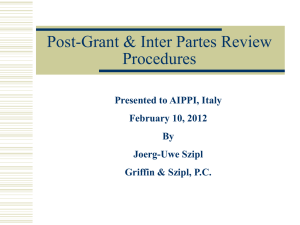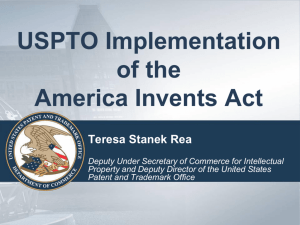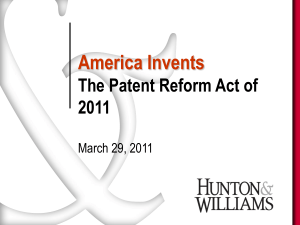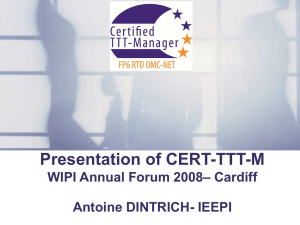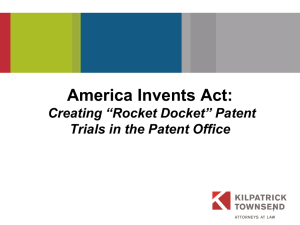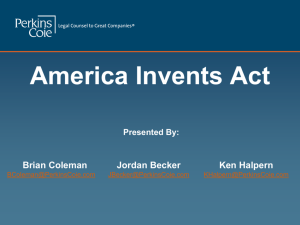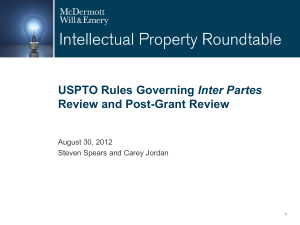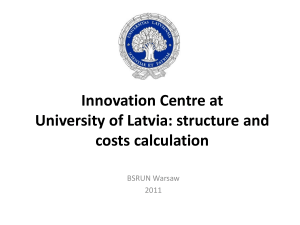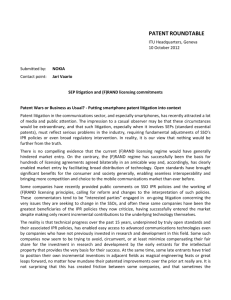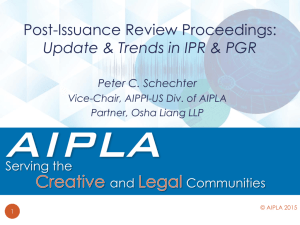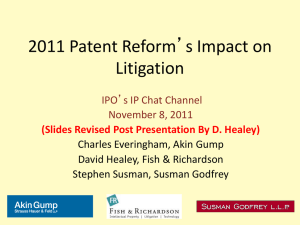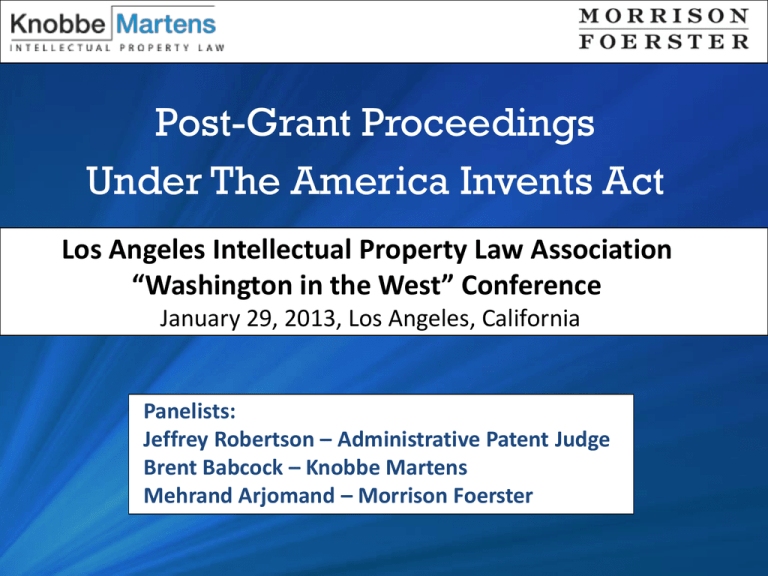
Post-Grant Proceedings
Under The America Invents Act
Los Angeles Intellectual Property Law Association
“Washington in the West” Conference
January 29, 2013, Los Angeles, California
Panelists:
Jeffrey Robertson – Administrative Patent Judge
Brent Babcock – Knobbe Martens
Mehrand Arjomand – Morrison Foerster
America Invents Act (AIA)
• Signed into law September 16, 2011
• General Themes (depending on
whom you ask)
– “Harmonization”
– Simplify and reduce cost of patent
litigation; alternative to patent
litigation
– Reduce influence of non-practicing
entities
– Varying effective dates
– Some uncertainty
• Technical Amendments (2013)
2
Changes to Post-Grant Disputes
Before AIA
After AIA
• Inter Partes Reexam
• Inter Partes Review
• Ex Parte Reexam
• Post-Grant Review
• Interferences
• Transitional Program for
Covered Business
Method Patents
• Derivation Proceedings
• Ex Parte Reexam
• Supplemental
Examination
• Interferences (Legacy)
3
Post-Grant Proceedings-Where We Are Now
• Current USPTO statistics as of January 24, 2013
– 114 IPR filings ; 3 instituted/ 0 denials
– 15 CBM filings; 2 instituted / 0 denials
• Number of Petitions by Technology
• Electrical/Computer
• Mechanical
• Chemical
89
6
19
• Bio/Pharma
9
• Design
1
4
Inter Partes Reexam v. Inter Partes Review
• Two important differences between an inter partes
reexamination proceeding and an inter partes review
proceeding:
– No examination
– Statutory deadline for final decision
Filing
Filing
Examination by CRU
Review by PTAB
Appeal to PTAB Appeal to CAFC
Appeal to CAFC
5
Post-Grant Proceedings – Procedure
• Threshold “Reasonable Likelihood” that petitioner will
prevail on at least one claim
• Potentially more limited discovery in IPR than Post Grant
Review
– Deposition of witnesses submitting affidavits (declarations)
– What is “otherwise necessary in the interests of justice”
• Patent owner may file response rebutting petition
• One motion by right to cancel or propose substitute claims
• Right to oral hearing
• Petitioner may submit supplemental information/
comment
6
Post-Grant Proceedings – Procedure
7
Post-Grant Proceedings – Procedure
• Petitioner or Director may request joinder of additional
parties
• Final determination within 12 months, up to 18 months
if “good cause”
• Estoppel: “raised or reasonably could have raised”
• Appeal: directly to Federal Circuit
8
Post-Grant Proceedings – Developments
• Representative Orders, Decisions, and Notices
http://www.uspto.gov/ip/boards/bpai/
representative_orders_and_opinions.jsp
• Pro Hac Vice Requests
• Defective Petitions
• Relationship with Co-pending Proceedings
• Definition of Covered Business Method Patent
9
IPR Strategic Issues
• What is the anticipated fees/cost of an IPR?
• How long will an IPR last?
• Are the fees/costs spread out evenly?
• Why should I use IPR rather than traditional litigation?
• What is the likelihood that a district court action will be
stayed during an IPR?
• Should I change my practices of monitoring
competitors’ IP?
• Is there anything I can do to prevent an IPR of my
client’s patents?
10
Advantages of IPR vs. Litigation
• Lower Burden of Proof (preponderance of the
evidence)
• Broadest Reasonable Interpretation of patent claims
• Lower Cost (FRCP do not apply)
– Limited discovery
– Professionalism strictly enforced
– Fewer “ancillary” battles (venue, jurisdiction,
discovery, etc.)
• Quicker (1-2 years)
• Better informed decision maker (both technical &
legal)
11
Advantages of Litigation vs. IPR
• Infringement can be adjudicated
• Full scope of claims and defenses
• Full discovery opportunities
• Estoppel effect of USPTO Inter Partes proceedings
• More expensive to opponent
• Jury presents potentially more risk to opponent
12
Thank you!
©2012 Knobbe Martens, Olson & Bear, LLP all rights reserved.
13

